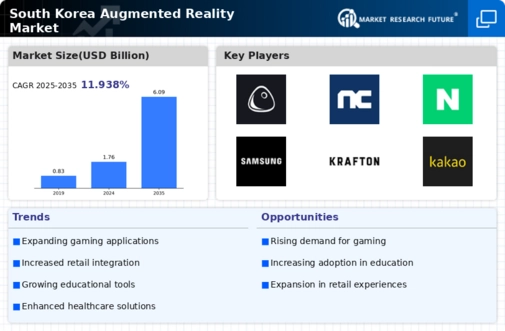Rising Demand in Healthcare
The healthcare sector in South Korea is increasingly adopting augmented reality technologies, which is significantly impacting the augmented reality market. AR applications are being utilized for surgical simulations, medical training, and patient education, enhancing the overall quality of care. The market for AR in healthcare is anticipated to reach $1 billion by 2026, reflecting a growing recognition of its potential benefits. Surgeons can visualize complex procedures in real-time, while medical students benefit from interactive learning experiences. This trend indicates a shift towards more innovative healthcare solutions, suggesting that the augmented reality market will continue to expand as healthcare providers seek to improve patient outcomes and operational efficiency.
Government Initiatives and Support
Government initiatives in South Korea are playing a crucial role in the growth of the augmented reality market. Various programs aimed at promoting digital innovation and technology adoption are being implemented, which include funding for AR startups and research projects. The South Korean government has allocated substantial resources to develop smart cities, where AR applications can enhance urban living through improved navigation and information dissemination. This support is likely to stimulate the market, as it encourages collaboration between public and private sectors. By 2025, the augmented reality market is expected to benefit from these initiatives, potentially leading to a more robust ecosystem for AR development and deployment.
Technological Advancements in Hardware
The augmented reality market in South Korea is experiencing a surge due to rapid advancements in hardware technology. Innovations in mobile devices, such as smartphones and tablets, are enhancing AR capabilities, making them more accessible to consumers. The integration of high-resolution displays, improved sensors, and powerful processors allows for more immersive experiences. As of 2025, the market is projected to grow at a CAGR of approximately 30%, driven by these technological improvements. Furthermore, the development of AR glasses and headsets is expected to revolutionize user interaction, providing new avenues for applications in various sectors. This hardware evolution is likely to attract investments and foster collaborations among tech companies, thereby propelling the augmented reality market forward.
Consumer Engagement and Marketing Strategies
The augmented reality market is witnessing a transformation in consumer engagement strategies, particularly in marketing. Brands in South Korea are increasingly utilizing AR to create interactive advertising campaigns that resonate with consumers. By allowing users to visualize products in their environment, companies enhance the shopping experience, leading to higher conversion rates. As of 2025, it is estimated that AR-driven marketing strategies could boost sales by up to 20%. This shift towards experiential marketing indicates a broader trend where businesses leverage technology to connect with consumers on a deeper level. Consequently, the augmented reality market is likely to expand as more brands recognize the value of immersive experiences in driving customer loyalty.
Increased Investment in Gaming and Entertainment
Investment in the gaming and entertainment sectors is significantly influencing the augmented reality market in South Korea. The popularity of AR games and interactive experiences is driving developers to create innovative content that captivates users. As of 2025, the gaming industry is projected to contribute over $500 million to the augmented reality market, reflecting a growing consumer appetite for immersive entertainment. This trend is further supported by the rise of esports and virtual events, where AR technologies enhance viewer engagement. The collaboration between gaming companies and AR developers is likely to foster new opportunities, suggesting a vibrant future for the augmented reality market in the entertainment landscape.

















Leave a Comment